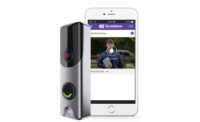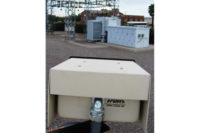Smart home capabilities are the sizzle that can help sell the security system steak. And smart locks are among the most sizzling smart home options. Here are six key developments in this area — and seven more that could be coming over the horizon.
6 Key Trends
Key trends in smart locks range from sophisticated software-enabled capabilities to hardware improvements that can enhance smart locks’ appeal.
-
Voice Control
“Voice assistants are just explosive,” observes Alice DeBiasio, vice president and general manager of professional security for Austin, Texas-based security manufacturer Resideo.
More and more homeowners now have voice assistants, also known as smart speakers, such as Amazon Echo and Google Home. And increasingly, security device manufacturers have integrated their offerings with those devices, enabling the devices to be voice controlled.
While Resideo doesn’t manufacture smart locks, the company has done integrations so that customers can lock their doors by saying, for example, “Alexa, tell Resideo Total Connect to lock my front door.”
-
Fully Keyless
Traditionally smart locks have also come with conventional keys so that homeowners can gain entry even if power is out. But Lake Forest, Calif.-based manufacturer Kwikset now has a smart lock that can be made operational by connecting a 9V battery, eliminating the need for customers to carry keys, explains Nick English, Kwikset national sales manager.
-
Retrofits
Manufacturers now offer more flexible smart lock installation. Adam Brandfass, senior product manager for Vienna, Va.-based Alarm.com Inc., notes that in the past, smart locks often required new holes to be drilled in a door, which was a turn-off to certain potential buyers — for example, those with ornately designed doors. Kwikset now offers retrofit options that eliminate the need to drill new holes, Brandfass explains, exposing smart locks to more potential buyers.
-
App Integration
While customers may like to have multiple types of smart home devices, they are less likely to enjoy having to use separate smartphone apps for separate device types. Initially that was a common requirement, but increasingly, end users can use a single app to control multiple smart devices, including smart locks, English notes.
“There are a lot of partnerships going on to do that very thing,” he observes.
-
Geofencing
Some of the initial applications for geofencing involved smart thermostats, which could be automatically turned up or down when homeowners crossed a programmed perimeter around their homes. But increasingly that capability is being used in combination with smart locks to help ensure that homeowners don’t drive away without locking their doors, DeBiasio notes.
-
Small Businesses Protect Interior Doors
Traditional commercial access control systems used door controllers connected to solenoids and door handles that required several hours to install, driving the overall price to around $3,000 to $3,500 per door, explains Brad Aikin, channel led business leader for the security integration channel for Schlage, an Allegion brand, Carmel, Ind. But as smart lock technology has made its way into the commercial market, leveraging existing IP network infrastructure and requiring only about an hour of installation time, the cost has come down to $1,000 to $2,000 per door, Aikin observes. And that has brought changes to small- and medium-size businesses that traditionally only secured exterior doors but now are securing at least some interior doors as well, he notes.
Researchers Find Strong Interest in Smart Locks
Smart locks are catching on in a big way, according to research released from Parks Associates in February.
According to the researchers, 25 percent of U.S. broadband households intend to purchase a smart lock in the next 12 months — and more than a third (35 percent) of U.S. broadband households consider smart locks to be affordable.
The average number of smart locks per purchase was 1.2 in 2017, Parks Associates said.
Some households that intend to purchase smart locks said they would purchase standalone devices. But the majority expected to purchase smart locks as part of a home security or home control system.
7 Developments That Could Be Coming on The Horizon
Sources interviewed for this story also offered their take on smart lock developments that could be coming on the horizon. Although some experts emphasized that they are not necessarily referencing specific projects at their companies, their comments offer a sense of the direction the industry eventually could take on smart locks.
-
Biometrics
The convenience of smart locks could be enhanced through biometric controls that would enable the homeowner to gain entry based on a retina or fingerprint scan, DeBiasio notes.
-
Embedded Video
Noting the popularity of doorbells that have embedded video, DeBiasio also believes we may see smart locks that have built-in video.
-
Encryption
DeBiasio expects to see the security of smart locks enhanced through higher levels of encryption in the future.
-
Power over Ethernet Advances
As commercial smart locks increasingly rely on power over Ethernet (PoE) connectivity, Aikin expects to see manufacturers improve on PoE technology so that the technology supports longer battery life and the ability to connect more devices to a single PoE switch.
-
Security as a Continuum
Aikin also expects to see manufacturers offer more flexibility in the level of security that smart locks provide. While some business customers may want a higher level of security that requires an end user to enter a PIN code, others may want fewer restrictions and may want their office to be unlocked by the time they get there, he observes.
-
Simplifying Communications
English sees an opportunity for manufacturers to improve the smart lock experience by bridging communications protocols such as Z-Wave, Wi-Fi and Bluetooth so that end users don’t have to be concerned with which protocol a device uses.
-
The Multi-Family Market
Brandfass expects to see smart locks designed for the multi-family market. The hardware for those locks is typically different from the hardware used for single-family homes, he notes.
One thing is for sure: manufacturers continue to enhance smart locks. Already those enhancements are opening new opportunities for security dealers and their customers. And future enhancements could generate even more such opportunities.
More Online
For more on smart locks, visit SDM’s website, where you will find the following articles:
“Smarter Intelligent Locks and Hardware for the Intelligent Age”
www.SDMmag.com/intelligent-locks-for-the-intelligent-age
“Why Sell Smart Locks?”
www.SDMmag.com/why-sell-smart-locks
“Function Takes Many Forms in the World of Smart Locks”
www.SDMmag.com/function-takes-many-forms-in-the-world-of-smart-locks
“Starting the Smart Right at the Front Door”
www.SDMmag.com/starting-the-smart-right-at-the-front-door
“5 Things You Need to Know About Connected Locks”
www.SDMmag.com/5-things-you-need-to-know-about-connected-locks









